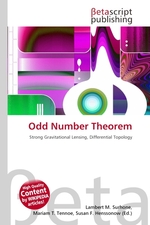Odd Number Theorem
Lambert M. Surhone, Mariam T. Tennoe, Susan F. Henssonow
бумажная книга
High Quality Content by WIKIPEDIA articles! The odd number theorem is a theorem in strong gravitational lensing which comes directly from differential topology. It says that the number of multiple images produced by a bounded transparent lens must be odd. In fact, the gravitational lensing is a mapping from image plane to source plane M: (u,v) mapsto (u',v'),. If we use direction cosines describing the bended light rays, we can write a vector field on (u,v), plane V:(s,w),. However, only in some specific directions V_0:(s_0,w_0),, the bended light rays will reach the observer, i.e., the images only forms at where D=delta V=0|_{(s_0,w_0)}. Then we can directly apply Poincare–Hopf theorem chi=sum text{index}_D = text{constant},. The index of sources and sinks is +1, and that of saddle points is ?1. So the Euler characteristic equals the difference between the number of positive indice n_{+}, and the number of negative indice n_{-},. For the far field case, there is only one image, i.e., chi=n_{+}-n_{-}=1,. So the total number of images is N=n_{+}+n_{-}=2n_{-}+1 ,, i.e., odd. The strict proof needs Uhlenbeck's Morse theory of null geodesics.
Данное издание не является оригинальным. Книга печатается по технологии принт-он-деманд после получения заказа.


